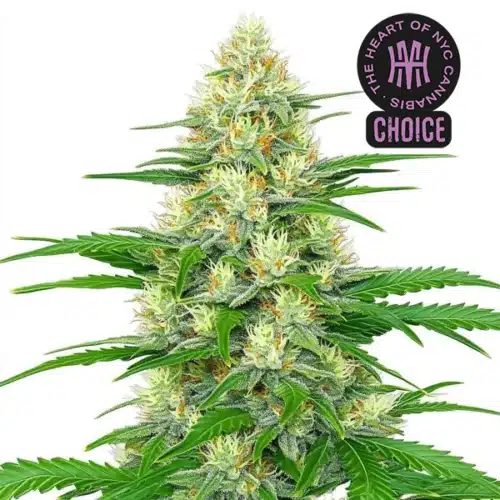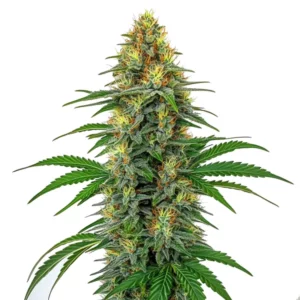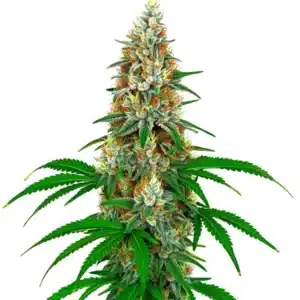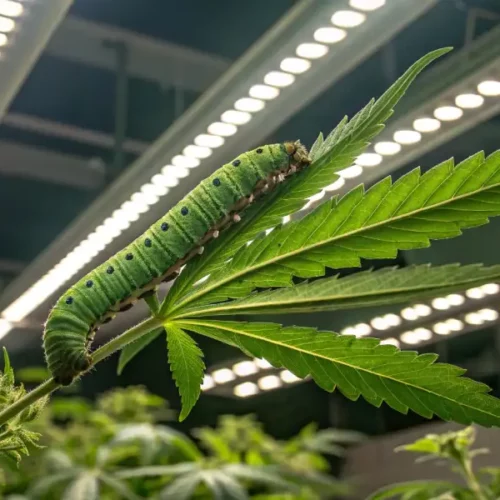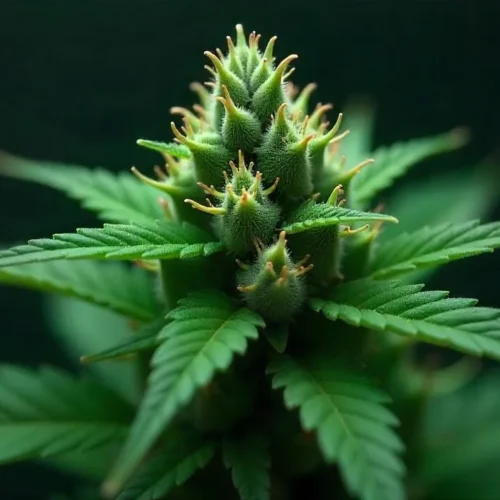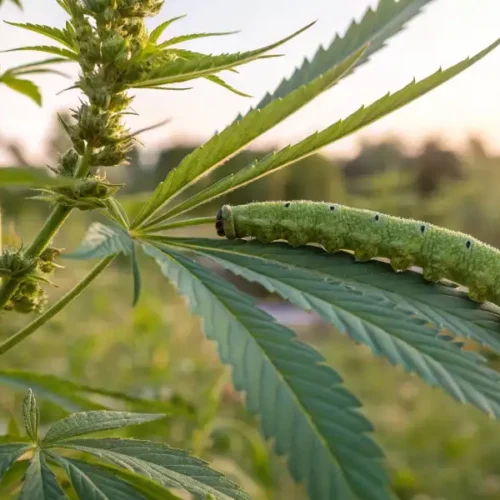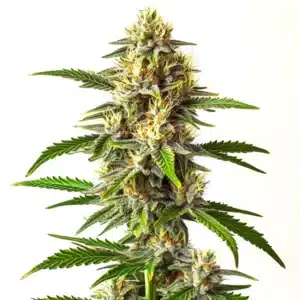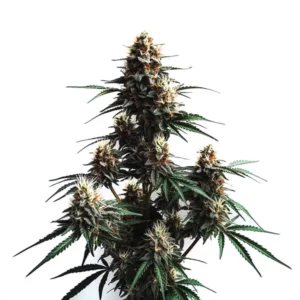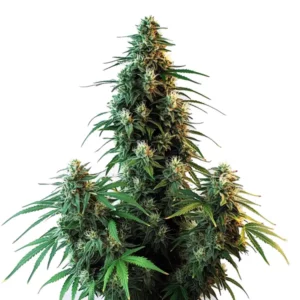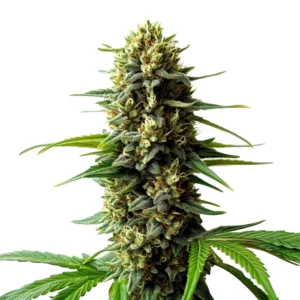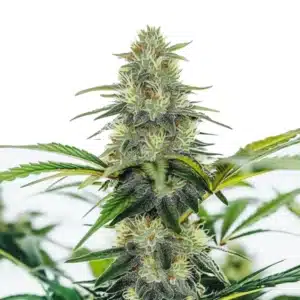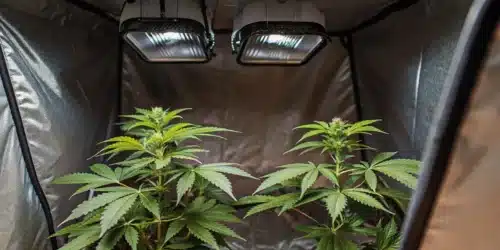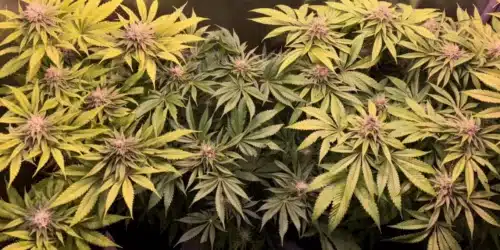Autoflower White Widow Strain Cannabis Seed Description
Autoflower White Widow Strain is a highly sought-after cannabis strain known for its ease of cultivation and potent effects. This article serves as a white widow autoflower grow guide and explains why the strain has gained popularity among cannabis enthusiasts for its unique characteristics.
AutoWhite Widow is a crossbreed of the classic White Widow and an autoflowering variety. This hybrid offers a balanced blend of Indica and Sativa genetics. It typically produces compact plants with dense buds covered in trichomes, making it an ideal choice for both indoor and outdoor cultivation.
Recommended Strains
White Widow Autoflower HMC Edition
 THC: 20 - 25
THC: 20 - 25 Type of seed: Autoflowering
Type of seed: Autoflowering Phenotype: Mostly Sativa
Phenotype: Mostly Sativa Day to flower: 8 - 10 weeks
Day to flower: 8 - 10 weeks
White Widow Autoflower
 THC: 20 - 25
THC: 20 - 25 Type of seed: Autoflowering
Type of seed: Autoflowering Phenotype: Mostly Sativa
Phenotype: Mostly Sativa Day to flower: 8 - 10 weeks
Day to flower: 8 - 10 weeks
One of the standout features of this Strain is its high THC percentage, often exceeding 20%. This potency results in a powerful and long-lasting effect, making it a favorite among both recreational and medicinal users.
Flavor-wise, the autoflowering white widow presents a delightful mix of earthy, woody, and citrus notes, adding a distinct touch to its aromatic profile. The combination of these flavors creates a pleasant and aromatic smoking experience.
Promos & Deals
Environmental Requirements for Growing Marijuana Autoflower White Widow
Creating the ideal environment for your Autoflower White Widow plants is essential to ensure their successful growth and development. The environmental requirements of this strain will help you provide the best conditions for a thriving cultivation process.
Auto White Widow Strain thrives in a temperate climate with temperatures ranging between 70-80°F (21-27°C) during the day and slightly cooler temperatures at night. It’s crucial to maintain a stable temperature and humidity level within the grow space to prevent stress or potential issues such as mold or mildew.
When growing this Strain indoors, providing adequate lighting is crucial. High-quality LED grow lights or HPS lamps are recommended to ensure proper photosynthesis and robust bud development. During the vegetative phase, provide a light cycle of 18-20 hours of light per day and switch to 12 hours of light and 12 hours of uninterrupted darkness to initiate flowering.
For outdoor cultivation, choose a location with ample sunlight and a favorable climate. Autoflower White Widow thrives in a sunny and warm environment, allowing it to reach its full potential. If you live in a region with cooler climates, consider using a greenhouse or providing additional protection to extend the growing season and safeguard your plants from adverse weather conditions.
Setting Up The Growing Cannabis Space
Before you begin growing, consider that white widow auto cultivation can benefit from an efficient and well-organized growing space to maximize plant potential. Whether you choose to cultivate indoors or outdoors, the following factors should be considered:
Indoor Cannabis Cultivation
For indoor growers, selecting the right grow tent or dedicated grow room is crucial. Ensure that the space provides sufficient room for the plants to grow vertically and has proper ventilation to maintain a fresh airflow. Install an efficient exhaust system with a carbon filter to control odors and prevent the accumulation of heat or humidity. Use reflective materials or Mylar sheets to maximize light distribution and avoid light leaks that could disrupt the flowering phase.
Choose a suitable growing medium for this Strain, such as high-quality soil or a hydroponic system, depending on your preferences and experience. Ensure proper drainage to prevent waterlogging and maintain a balanced pH level of around 6.0-6.5 for optimal nutrient absorption.
Outdoor Cannabis Cultivation
When cultivating Autoflower White Widow outdoors, select a location with plenty of sunlight and suitable soil conditions. Ensure the soil is well-draining and rich in organic matter. Consider using large containers or fabric pots to have better control over soil quality and root health. Additionally, protect your plants from strong winds by placing them near a fence or using windbreaks.
Using stakes or trellises to support the branches of your Auto White Widow plants is recommended. This helps prevent the branches from bending or breaking under the weight of the dense buds and promotes better airflow.
Propagation and Germination of Marijuana Seeds
Successful germination and propagation are essential for healthy and vigorous Strain plants. Follow these steps to ensure a high germination rate and successful propagation:
1. Start by selecting high-quality Autoflower White Widow seeds from a reputable seed bank. This ensures genetic stability and the feminization of your plants.
2. Begin the germination process by soaking the seeds in distilled water or a damp paper towel for 24-48 hours. Maintain a temperature between 70-85°F (21-29°C) and provide a dark and undisturbed environment.
3. After the seeds have soaked and developed taproots, transfer them carefully to a pre-moistened growing medium, such as a seedling tray or small pots filled with a light and well-draining soil mix.
4. Place the seeds in a warm and humid environment with gentle airflow. Maintain a temperature around 75-80°F (24-27°C) and a humidity level of 60-70% for optimal germination.
5. Provide indirect light to the seedlings during the first few days, gradually increasing the light intensity as they develop. Avoid exposing them to intense light or heat that could cause stress or damage.
6. Once the seedlings have developed a few sets of true leaves, they are ready to be transplanted into larger pots or the final growing containers.
By following these germination and propagation steps, you can set the stage for auto white widow feminised plants that develop into a robust and high-yielding crop.
Vegetative Phase of Cannabis seeds Autoflower White Widow Strain
The vegetative phase is a crucial stage in the development of this Strain plants. Here are some key considerations during this phase:
Lighting: Provide this Strain plants with 18-20 hours of light per day to promote vigorous vegetative growth. High-quality LED grow lights or HPS lamps are recommended to ensure sufficient light intensity and spectral distribution.
Nutrition: During the vegetative phase, your Autoflower White Widow plants require a balanced and nutrient-rich diet. Use a reputable cannabis fertilizer with a higher nitrogen (N) content to encourage healthy leaf and stem growth. Follow the manufacturer’s instructions and monitor the plants for any signs of nutrient deficiencies or excesses.
Watering: Water your plants when the top inch of the soil feels dry. Avoid overwatering, as it can lead to root rot and other moisture-related issues. Allow the soil to dry out slightly between watering sessions, but ensure the plants do not experience extreme drought.
Training: Consider employing training techniques such as low-stress training (LST) or topping to control the height and shape of your Auto White Widow plants. These methods help create an even canopy, increase light penetration, and promote better bud development.
Pruning: Remove any lower branches or leaves that receive little light or show signs of disease or pests. This helps improve airflow and reduces the risk of mold or mildew formation.
By providing this plants with the right environmental conditions, nutrition, and care during the vegetative phase, you can establish healthy and robust plants ready for the flowering stage.
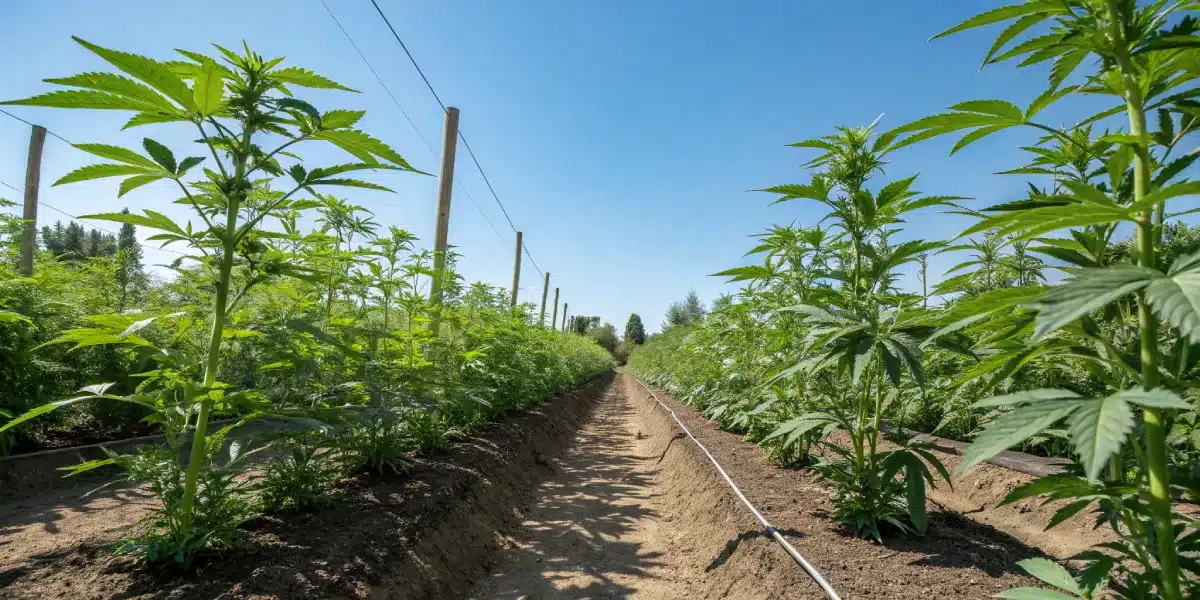
Flowering Phase of Marijuana Seeds Autoflower White Widow Strain
The flowering phase is the most anticipated stage of growing Autoflower White Widow Strain, as it is when the plants develop their characteristic buds. Here’s what you need to know:
Lighting: Adjust the light cycle to 12 hours of light and 12 hours of uninterrupted darkness to initiate the flowering phase. Use a timer to maintain a consistent light schedule. During this stage, your Auto White Widow plants require intense light, so ensure your grow lights provide adequate coverage and maintain the appropriate distance from the canopy.
Nutrition: Transition from a nutrient formula higher in nitrogen to a bloom or flowering-specific nutrient formula. These formulations are generally higher in phosphorus (P) and potassium (K), which promote bud development and overall flowering performance. Monitor the plants closely and adjust nutrient levels as needed to avoid deficiencies or toxicities.
Temperature and Humidity: Maintain a slightly lower temperature during the flowering phase, ideally around 65-75°F (18-24°C), to encourage resin production and prevent heat-related stress. As for humidity, aim for levels around 40-50% to minimize the risk of mold or bud rot.
Support: As this plants enter the flowering phase, the weight of the developing buds may cause branches to bend or break. Provide adequate support using stakes or trellises to ensure the plants can bear the weight and avoid bud damage.
Flowering Time: Autoflower White Widow typically has a flowering time of 8-10 weeks, but this can vary depending on the specific phenotype and environmental conditions. Monitor the trichome development using a magnifying tool to determine the optimal harvest window.
Throughout the flowering phase, integrating practices from a white widow auto flower cultivation perspective will help maintain plant health and ensure a quality final product. Implement proper pest management practices and take immediate action at the first sight of infestation or abnormalities.
Cannabis Fertilization and Nutrition
Proper nutrition and fertilization are crucial for maximizing the growth, yield, and overall health of your Auto White Widow Strain plants. Consider the following tips:
Choosing the Right Fertilizer: Select a high-quality cannabis-specific fertilizer or nutrient line that provides a balanced blend of macro and micronutrients. Look for products rich in nitrogen (N), phosphorus (P), and potassium (K) to support healthy growth, root development, and bud formation.
Feeding Schedule: Follow the manufacturer’s instructions and adjust the feeding schedule based on your plants’ specific needs. Start with a lower concentration and gradually increase it as the plants progress through their growth stages. Monitor the plants closely for any signs of nutrient deficiencies or excesses and make adjustments accordingly.
Supplements and Additives: Consider incorporating supplements and additives into your feeding regimen to enhance specific aspects of plant development. These may include bloom boosters, beneficial microbes, enzymes, or organic amendments that improve soil structure and nutrient availability.
Regularly monitor your plants’ response to the feeding program, adjusting nutrient concentrations and frequencies as needed. Remember to flush the plants with pure water during the final weeks of the flowering phase to remove any excess salts or nutrients, which can affect the flavor and overall quality of the final harvest.
Pest And Disease Control for Cannabis Growing
While this Strain is known for its resilience, it is still susceptible to pests and diseases. Implementing proper pest and disease control measures is crucial to protect your plants and ensure a successful cultivation. Here are some preventive and corrective actions:
Prevention:
- Regularly inspect your plants for any signs of pests, such as spider mites, aphids, or thrips. Early detection is key to preventing a full-blown infestation.
- Maintain a clean and tidy growing space, removing any dead plant material or debris that could harbor pests or pathogens.
- Introduce beneficial insects, such as ladybugs or predatory mites, to your garden to help control pests naturally
Cultural Practices:
- Practice good hygiene by washing your hands and changing your clothes before entering the grow space to prevent introducing pests from the outside.
- Rotate crops if growing outdoors to reduce the buildup of soilborne pests and diseases.
- Use a well-draining growing medium to discourage the development of root rot and other soil-related issues.
Corrective Measures:
- If you identify a pest infestation, consider using natural remedies such as neem oil or insecticidal soap to control the problem.
- For more severe infestations, you may need to resort to chemical pesticides. Ensure that any pesticides you use are approved for use on cannabis and follow the instructions carefully, including proper application and safety precautions.
- For fungal diseases, such as powdery mildew or botrytis, maintain proper ventilation, reduce humidity, and consider using organic fungicides if needed.
- Remove and isolate any infected plants to prevent the spread of diseases to healthy ones.
Regular monitoring and a proactive approach to pest and disease management will help keep your this plants healthy throughout their growth cycle.
Harvesting and Curing for Cannabis Growing
Harvesting and curing your Autoflower White Widow Strain buds correctly are essential steps to maximize their quality and potency. Here’s a guide to help you through this crucial phase:
Harvest Timing: Monitor the trichomes on your buds with a magnifying tool to determine the ideal harvest time. Harvest when the trichomes have turned cloudy or amber, indicating peak cannabinoid production. Avoid harvesting too early when trichomes are mostly clear.
Harvest Technique: Use clean, sharp pruning shears or scissors to cut the branches with the mature buds. Handle the buds gently to avoid damaging the delicate trichomes.
Trimming: Trim away excess fan leaves and sugar leaves from the buds. You can use these trimmings for making concentrates or edibles if desired.
Curing: Place the trimmed buds in glass jars with airtight lids. Store the jars in a cool, dark place with a temperature of around 60-65°F (15-18°C) and a humidity level of 55-65%. Burp the jars daily for the first week to release excess moisture and promote even curing. After the initial week, burp the jars less frequently, gradually reducing it to once a week or less.
Curing Duration: Curing typically lasts for at least 2-4 weeks, although some growers prefer a longer curing period of 6-8 weeks or more for enhanced flavor and smoothness. Properly cured buds will develop a well-rounded flavor profile and a smoother smoke.
By following these steps, you can ensure that your Auto White Widow buds are properly harvested, trimmed, and cured, resulting in a premium final product with excellent aroma, flavor, and potency.
Autoflower White Widow Strain: Indica or Sativa?
This Strain is considered a hybrid strain that combines characteristics of both Indica and Sativa genetics. It offers a well-balanced experience, making it suitable for a wide range of users.
The Indica genetics contribute to its compact growth structure, dense buds, and relaxing body effects. On the other hand, the Sativa genetics provide a euphoric and uplifting cerebral high. This balance between the two makes this Strain versatile and appealing to those who enjoy a mix of physical and mental effects.
Advantages of Growing Autoflower White Widow Seeds
There are several advantages to growing Autoflower White Widow seeds:
- Shorter Growth Cycle: Autoflowering strains like White Widow have a shorter life cycle, typically around 8-10 weeks from seed to harvest. This allows for quicker and more frequent harvests compared to photoperiod strains.
- Compact Size: This Strain plants tend to stay relatively small, making them suitable for growers with limited space or those looking to maintain a discreet garden.
- High Potency: This strain is known for its high THC content, delivering potent effects that can be enjoyed by both recreational and medicinal users.
- Adaptability: This Strain is adaptable to various growing environments, including indoor and outdoor settings. Its resilience makes it forgiving for novice growers.
- Unique Flavor Profile: The combination of earthy, woody, and citrus flavors provides a distinctive and enjoyable smoking or vaping experience.
Disadvantages of Growing Autoflower White Widow Strain Cannabis Seeds
While Autoflower White Widow Strain offers numerous advantages, it also comes with some disadvantages:
- Lower Yield: Compared to some photoperiod strains, autoflowering varieties typically yield smaller harvests.
- Less Control: Autoflowering plants have a predetermined life cycle and cannot be manipulated by adjusting light schedules. This limits the grower’s control over the plant’s size and development.
- Reduced Training Options: Due to their shorter growth cycle, autoflowering strains have limited time for training techniques like topping and LST, which may impact yield potential.
- Shorter Vegetative Phase: The abbreviated vegetative phase means less time for recovery or corrective action if any issues arise during this stage.
- Seed Availability: This Strain seeds are available, their availability may be more limited compared to traditional photoperiod strains.
Why buy Autoflower White Widow Strain Marijuana Seeds
If you’re considering growing Autoflower White Widow Strain marijuana seeds, there are several reasons to make this choice:
- Convenience: Autoflowering seeds are known for their simplicity and ease of cultivation, making them an excellent option for novice growers or those with limited experience.
- Quick Harvests: The short life cycle of autoflowering strains means you can enjoy multiple harvests in a single growing season, allowing for a continuous supply of fresh buds.
- High Potency: This Strain is renowned for its potency, providing both recreational and medicinal users with a potent and enjoyable experience.
- Versatility: These seeds can thrive in various environments, making them adaptable to indoor, outdoor, and greenhouse growing setups.
- Distinct Flavor: This Strain offers a unique flavor profile with a combination of earthy, woody, and citrus notes that many users appreciate.
Before purchasing Auto White Widow marijuana seeds, ensure that you have the necessary growing conditions, equipment, and knowledge to provide your plants with the care they need throughout their lifecycle.
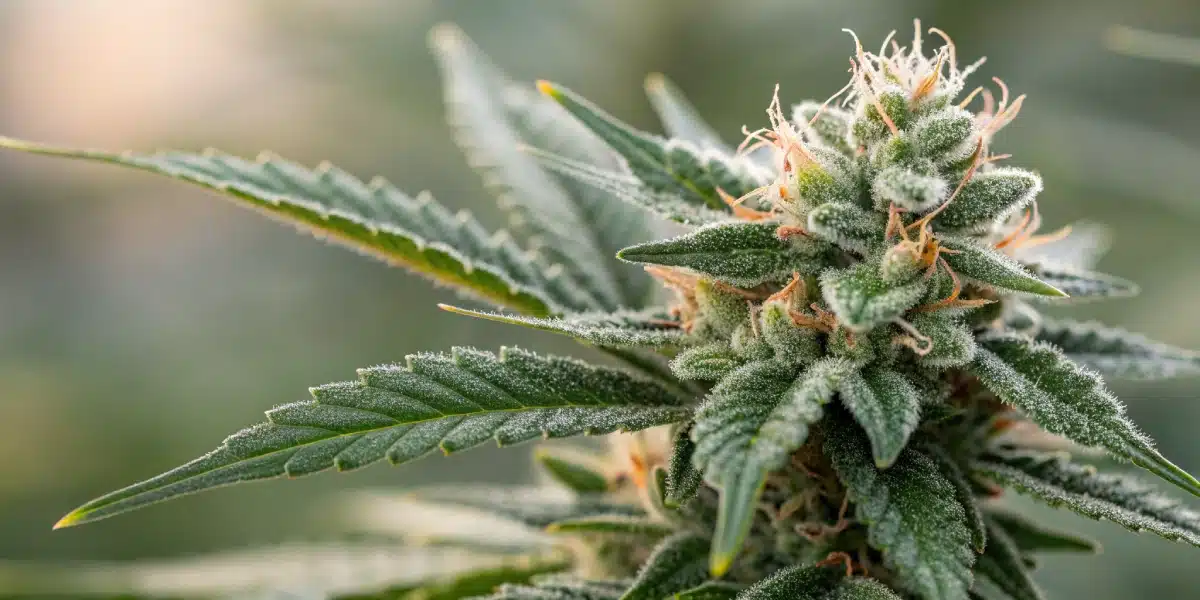
FAQs About Autoflower White Widow Strain Marijuana Seeds
Can I grow Autoflower White Widow Strain seeds indoors?
Yes, You can be successfully grown indoors. Indoor cultivation provides greater control over environmental factors, allowing you to optimize conditions for your plants’ growth.
What is the average yield of Autoflower White Widow Strain plants?
The average yield of this Strain plants can vary depending on factors such as the growing environment, plant care, and the specific phenotype. However, they typically produce moderate yields compared to some other strains.
How long does it take for Autoflower White Widow Strain to flower?
This Strain typically takes around 8-10 weeks from germination to harvest. The flowering phase starts automatically without the need for a change in light cycle.
What kind of lighting should I use for Autoflower White Widow Strain indoors?
For indoor cultivation, you can use high-quality LED grow lights, HPS (High-Pressure Sodium) lamps, or other suitable grow lights designed for cannabis. Ensure that the light intensity and spectrum are appropriate for each growth stage.
Can I grow Autoflower White Widow Strain seeds outdoors?
Yes, this Strain seeds can be grown outdoors in regions with a suitable climate. Ensure that you plant them during the appropriate season when the outdoor conditions are optimal.
What is the THC content of Autoflower White Widow Strain?
This Strain is known for its high THC content, which can range from 18% to 25% or even higher in some cases. The actual THC levels can vary between individual plants and growing conditions.
Can I clone Autoflower White Widow Strain plants?
While it’s possible to clone this Strain plants, it’s not commonly practiced due to their short life cycle and the need for a mother plant to provide clones. Autoflowering strains are typically grown from seed for simplicity and speed.

